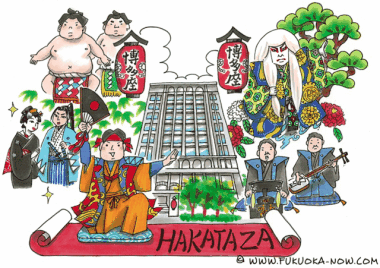Hakata Culture vol.99
Nakasu-Kawabata: A Center of Entertainment since the Edo Period

Every month, the Hakataza Theater plays host to a range of different performances, from kabuki to musicals to plays. As the largest theater in Kyushu, it draws audiences from all over western Japan. To accommodate various types of performances, the theater has been outfitted with a revolving stage, a runway, side runways, an orchestra pit, a naraku (an under-stage pit with a trapdoor used in kabuki) and a toya (a small room at the end of the runway used in kabuki). In fact, Hakataza is only one of a few theaters in Japan with this much equipment.
「This May, the Yukigumi ("Snow Troupe") of the all-female Takarazuka Revue will perform at the theater. The leader of the troupe was born in Kyushu, so you can expect her to put on a fantastic show for the hometown crowd. June marks the return of the Grand Kabuki, which has played at Hakataza every year since it opened in 1999. Before the show, the kabuki actors ride in boats down the nearby Hakatagawa River-an event that has fast become one of Hakata's early summer traditions.
The Nakasu-Kawabata neighborhood where Hakataza is located has been the city's entertainment center since the Edo period. Back then, there were no permanent playhouses; instead, makeshift structures were erected on the grounds of temples and shrines or next to rivers. Kabuki and jōruri (puppet theater) performances were held at Kushida Shrine and Daijo-ji Temple, and sumo matches and plays were held in Hamashinchi, the district on the north side of Nakasunakashimamachi.
Later, in the Meiji and Taisho periods, permanent playhouses with names like Kyorakusha, Eirakusha, Meijiza and Taihaku Theater started to appear in the area. In 1910, Otojirō Kawakami, a famous Hakata-born actor, built a western-style theater on what is now the site of Higashi Park. He called the two-story, 1,000-seat theater Hakataza-which is the namesake of today's Hakataza Theater.
博多座界隈は江戸時代から芝居の中心地
歌舞伎、ミュージカル、演劇など、月替わりでさまざまな演目が上演される博多座。九州では最大級の劇場で、西日本一帯から芝居好きの観客が訪れます。あらゆる演目に対応できるよう、劇場に必要とされる「回り舞台」「花道」「袖花道」「奈落」「オーケストラピット」「鳥屋(とや)」などを備えていますが、これだけの設備がある劇場は全国でもめずらしいそうです。
今年5月は宝塚歌劇雪組の公演です。現在の雪組のトップコンビは九州出身なので、故郷で素晴らしい舞台を見せてくれそうです。また6月は毎年恒例の博多座大歌舞伎。1999年のこけら落とし以降、6月には必ず歌舞伎が上演されています。公演に先駆けて、博多座の横を流れる博多川で歌舞伎役者たちによる「船乗り込み」が行われます。こちらも今では博多の初夏の風物詩としてすっかり定着しました。
博多座のある中洲・川端地区は江戸時代から芝居など興行の中心地でした。といっても昔は常設の芝居小屋はなく、寺社の境内や河原などに臨時の小屋を建てて上演していました。櫛田神社やその北側にあった大乗寺(だいじょうじ)では歌舞伎や浄瑠璃などが上演され、また中洲中島町の北側の浜新地では相撲や芝居が行われていました。
明治以降になると常設の芝居小屋が登場します。中洲・川端地区には「教楽社」「永楽社」「明治座」「大博劇場」といった劇場が、明治から大正にかけていくつも建てられました。また博多が生んだ著名な演劇人・川上音二郎は、1910(明治43)年に現在の東公園の場所に洋風の劇場を建てます。2階建て、収容人数1000名の大劇場で、名を「博多座」といいます。現在の博多座は、この劇場の名前を踏襲したものなのです。

